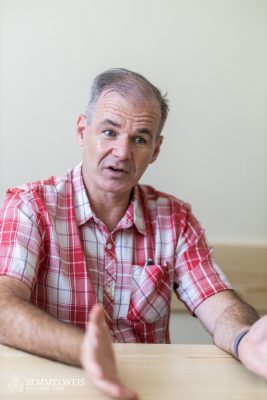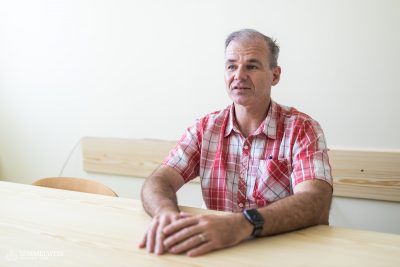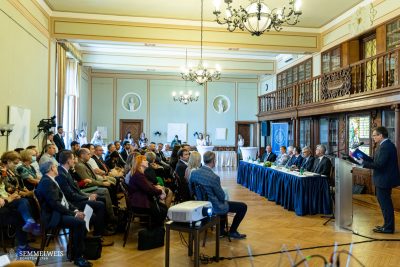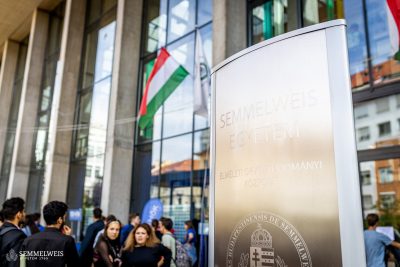An international workshop on nonparametric population pharmacokinetic modeling and the individualization of drug therapy was hosted by Semmelweis University’s Department of Laboratory Medicine from June 6-8. The workshop lecturer was Michael N. Neely, Professor at the University of Southern California, and Chief of the Division of Infectious Diseases at Children’s Hospital Los Angeles whose attendance was supported by the Erasmus+International Credit Mobility Programme. We asked the American authority on personalized medicine at the Theoretical Block of Nagyvárad tér.
After a pause caused by the coronavirus pandemic and the passing away of professor Jelliffe, professor Neely came to our University to hold this year’s 3-day regular workshop of ITAG between 6-8 June. Over 30 participants joined the hybrid event from Bulgaria, France, Germany, Great Britain, Hungary, Norway, Poland and Spain to gain hands-on insight into the construction of population pharmacokinetic models, the prediction of future concentrations, and model-informed precision dosing. Those who came also had the opportunity to work on their scientific projects relying on these softwares, and to consult related issues with professor Neely, benefiting profoundly from the participation.
Why is personalized medicine a growing field in healthcare?
Michael N. Neely: There are several reasons. Our testing capability has really improved. A key component of personalized medicine is genetics, and our ability to understand the genetics of individual patients is so much better now than used to be. We are also able to test blood samples and other samples to understand how genetics influences how our body functions. From my perspective personalized medicine is about precision dosing. I often say that surgeons use scalpels with great skill, dexterity and finesse, but we physicians are not surgeons, our tools are often medicines, drugs. Unfortunately in the past we tended not to use them like scalpels, we used them like hammers, with everybody getting the same dose. But I think with the improved ability for testing drug concentrations with speedy turn around times, more and more hospital laboratories can measure drug concentrations, you don’t have to send them off to another facility, and we get our results much faster. We have the ability now to have more finesse on how we use drugs. For precision dosing you need computers to help you, you really have to analyze the data. Modern physicians, the younger ones in particular have grown up with computers, they can’t imagine life without computers, and so practicing with a computer in their hands is natural. Therefore, the idea that I can have a computer that can help to come up with a dose is not a problem for younger physicians.
Is the main advantage of all this a more accurate drug dosing?
Exactly. I guarantee you if I just give the same dose to different persons, everyone will have different concentrations of the drug in their blood, and will have different effects as a result. In the past we just said, you had a toxic side effect because maybe there is too much drug in your blood. We just said, oh, bad luck, we did not get the effect we wanted. Nowadays we can say, maybe you are toxic because that dose was too big for you. Maybe you did not get the effect because we didn’t give you enough drug. It can be completely different for different patients, and now we have the ability to know that.
How do you use mathematical models in this approach?
A mathematical model is just a way for the computer to capture our past experience. If I prescribe a drug to you as a patient, I’m pretty sure you are not going to be the very first human being in the world ever to get that drug, lots of other patients have had that drug. We know something about how the drug behaves in other humans. That’s what the model does, it captures that experience. I can interpret your specific situation in a context of all that experience to help make a better therapy for you.
You are a specialist of infectious pediatric diseases. Is this the field where personalized medicine is the most useful?
I think it is general. Using precision dosing is generalized in any field of medicine. Yes, I am a pediatrician, an infectious disease specialist, so I deal with antibiotics all the time, and with bad infections in children. But cancer drugs given to cancer patients, whether they are children or adults, they are some of the most toxic drugs, and there is a very tight margin where too much can be very harmful to the patient, while too little means we don’t get rid of the tumor. So oncology, neurology, control of seizure medicines also are perfect for precision dosing. Transplantation: all those patients walking around with different organs in their body from donors, they need medicines in order to keep their immune system lower so they do not reject. All perfect for precision dosing.
Does your research concern the same area?
All of my research is geared towards how I can try to get the best dosing for my individual patient in front of me. But I have lots of different areas to work in towards that goal. Some of it is what I have been doing here in Budapest, which is the software, to make the models and use them, to the optimized dosing. I also have a laboratory where we are running experiments to understand how do I chose the right target, the right concentration for that particular infection.
What kind of cooperation do you have with Semmelweis University?
I’ve known Dr. Gellért Karvaly for 7 years, this is our second workshop in Budapest. We have a growing partnership of cooperation for training and teaching the next generation on how to build and use these models. Dr. Karvaly has the laboratory to do all the measurements to get the drug concentrations that we need for these models. I don’t even have that in my laboratory. So it’s a really great service that he offers both to Semmelweis University and hospital patients in Budapest and all of the country. My laboratory is quite different than his. We have lots of instruments and tools but we don’t do so much the measurement on drug concentrations interestingly. I use my hospital laboratory for that. Mostly because in the USA there are strong restrictions, you can’t use research facilities to manage patient care. You have to use clinical certified hospital laboratory.
How can personalized medicine be spread worldwide? Is it a question of money?
It is a big question how we could spread personalized medicine. It is slow. It’s a culture change. Changing the culture of medicine is rather like steering a very large ship. It takes a long time to actually see the effects of the turn that you might be making in the wheelhouse. It’s a combination of things: teaching, workshops like we do here to spread the word, especially to the younger generations as they see the benefits that can happen when you do that. Interacting with government agencies, for instance I often have talks with the Food and Drug Administration (FDA) about the benefits of personalized medicine. I was really happy, just before Covid, in August 2019, the FDA hosted its first workshop on precision dosing. It is important continuing to develop more assays because you can’t do personalized medicine and precision dosing if you can’t get your drug concentration measured quickly.
What is your estimation, how much percentage does personalized medicine represents of the total healthcare?
Small percentage, still. I think it depends on the area, so for example for drugs like vancomycin, which is an antibiotic that we give intravenously to treat some serious infections, almost every hospital in the world is going to measure vancomycin concentrations and try to do some kind of precision dosing. More and more they are turning to computer programs. But if you look at some cancer drugs, maybe nobody or very few people are yet doing that. So, it really depends on the drug and the field of medicine.
How can personalized medicine be developed?
To develop it, one of the things is, the role of the physicians. Ultimately the physicians are the people who generally are in contact with the patient. If a physician has an experience where he sees the benefit of precision dosing, suddenly he says, I want to do it again and again, and then it grows. Also, as more and more studies accumulate, national organizations write treatment guidelines, and they incorporate precision dosing into the guidelines. Vancomycin is a great example again. I would say in a large part due to the studies that we did, other people also but we did some important studies, we got national guidelines changed in the US, to say this is how you should be doing precision dosing for vancomycin.
What are your projections for the next decades in this area?
I think it is going to increase because computers will continue to become larger and larger part of care and decision support. We have so much data now in our computer systems related to healthcare. In most places of the world they don’t use as much papers any more, they have all the laboratory and hospital results on computer records. In the past it has been designed to be kept very secure: don’t release anybody’s private information. Now we are realizing we have so much data there, and the computers keep getting stronger, we can use artificial intelligence (AI) to learn something from all these data sitting there. So, in the next 10-20 years I think we are going to see more and more use of AI to help with personalized medicine and precision dosing, even in real time decision support when physicians and pharmacists are going to be looking at the data in computers saying, I’m analyzing the outcomes of 1 million patients and now I can give you projections of what’s going to happen with the patient sitting in front of you.
Michael N. Neely is a Board-certified pediatric infectious disease specialist with more than 20 years of experience in patient care and research. He serves as the Chief of the Division of Infectious Diseases at CHLA. He is Director of the CHLA Laboratory of Applied Pharmacokinetics and Bioinformatics, making him one of the world leaders in creating models of drug behavior that help identify the best drug dose for an individual patient to achieve the desired concentrations in the body. Through his work at The Saban Research Institute, he leads internationally recognized research efforts in pediatric clinical pharmacology and infectious diseases. He lectures internationally and has published more than 100 peer-reviewed publications as well as nine book chapters.
Gábor Kiss
Photo: Bálint Barta – Semmelweis University




